
Get Priorities Straight With Covey’s Time Management Matrix
This is blog #2 in our new series on coaching models. Sign up to our mailing list to make sure you don’t miss out on our future content.
As leaders, it can sometimes feel like we’re pulled in all different directions. When there’s seemingly no end to the to-do list and everything feels urgent… where do you begin?
The answer, of course, is to prioritise your tasks. But that’s a lot easier said than done.
Fortunately, there’s a really effective coaching model that’s perfect for prioritisation: The Time Management Matrix. To support you through this process, we’ve put together a little guide on how to apply this coaching model.
But first, let’s dig a little deeper into why we might need a coaching model like this…
Why Is Prioritisation So Hard?
We all have various responsibilities and commitments — both at work and at home. There are meetings to show up to, reports to deliver, emails to read, people to check in with, and the list goes on.
Most people automatically prioritise these responsibilities based on urgency. And although this may appear to be the logical approach, it’s actually not the most effective way to prioritise.
In fact, research suggests that this approach leads to people spending a lot of time focusing on unimportant and meaningless activities. A recent survey of 9,615 global knowledge workers found that an average of 3.6 hours were lost per week to unnecessary meetings and 62% of the workday was lost to repetitive, mundane tasks. Studies also show that people also tend to prioritise tasks with shorter completion windows first, even when their other tasks will lead to a greater reward.
This habit of focusing on urgent tasks (along with the associated adrenaline rush or fight-or-flight response) is a self-perpetuating cycle that can be hard to break. It makes people less effective at work and can even lead to chronic stress and other health problems.
To overcome a habit of focusing on urgency over importance and become more effective, you’ll first need to take a step back to reflect on the real priorities. And that’s where the Time Management Matrix comes in.
Introducing the Time Management Matrix
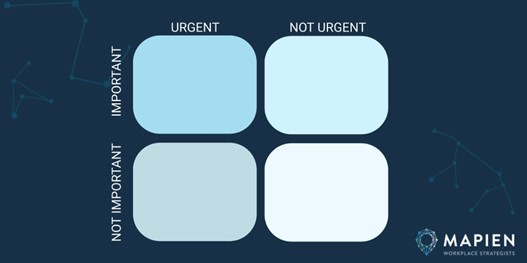
The Time Management Matrix conceptualises your commitments based on two factors: urgency and importance. It consists of four quadrants:
- Quadrant 1: Urgent and important
- Quadrant 2: Not urgent but important
- Quadrant 3: Urgent but not important
- Quadrant 4: Not urgent and not important
So, how do you figure out what activities go into what quadrant? And once you’ve organised them into quadrants… then what?
Let’s take a closer look at each of the quadrants, their purpose, and how to prioritise them.
Breaking Down the Four Quadrants
Quadrant 1: Do First
These are your urgent and important activities. In this quadrant, you might find emerging crises, deadline-driven projects, and genuine emergencies you need to deal with.
Generally speaking, you should address the commitments in this quadrant immediately, otherwise you could face some serious consequences.
Quadrant 2: Schedule
These are your important but non-urgent activities or commitments. Here, you might find relationship building, strategic planning, risk mitigation, systems set up, and health/recreational activities.
Most people tend to delay the commitments in this quadrant because they’re not urgent (yet). The problem with this is that most of your strategic and high-impact tasks usually fall under this category. So, even if you can’t make a start on them, you should immediately add these activities to your work schedule. If you spend most of your time working on these important but non-urgent scheduled tasks, you’ll be more effective and increase your output.
Quadrant 3: Delegate
These are your responsibilities that are urgent and not important. Inside this quadrant, you’ll often see interruptions like emails, phone calls, meetings, notifications, and other people’s issues or requests.
Spending too much time on these tasks will reduce your effectiveness and distract you from your most important goals. Although you can’t necessarily put these tasks off, consider whether you can delegate them to others or break them down into smaller chunks. This will allow you to stay focused on what matters.
Quadrant 4: Limit
Finally, these are your activities that are neither urgent nor important. In this quadrant, you’ll see any trivial or pleasant commitments that are otherwise a waste of time. Examples include social media, workplace drama, busywork, and media consumption. But of course, any activity that feeds your procrastination could fit into this category.
Although it’s good to find a balance and enjoy some downtime, it’s important to limit your time spent here and prioritise your commitments in the other three quadrants. Practice saying no to distractions that eliminate tasks that don’t bring you closer to your goals.
Where did this model come from?
The Time Management Matrix originates from Stephen Covey’s popular book, The 7 Habits of Highly Effective People. It’s covered under habit number three: ‘put first things first’. This habit involves determining which activities are most important and doing them in that order.
In Covey’s words, “The key is not to prioritise what’s on your schedule, but to schedule your priorities.”
We’ve previously shared about another coaching model from Covey’s book. Check out our blog on the Circles of Control, Influence & Concern.

How to Apply the Time Management Matrix
To apply the Time Management Matrix to your own situation, draw and label your quadrant on a piece of paper. Then work through the following four steps, using the visual examples to help guide you.
(1) Identify All Responsibilities
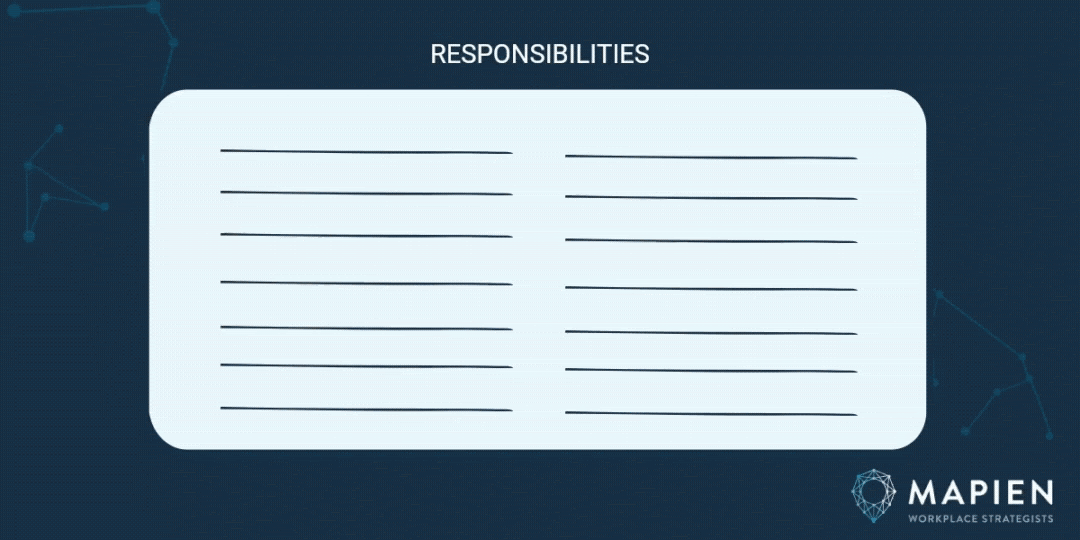
Start by writing out a list of all your existing responsibilities and commitments. If you’re trying to prioritise your work, keep these focused on work-related activities. If you’d like to apply the matrix to another area of your life, you can repeat this process separately.
As a leader, your list of responsibilities and commitments will likely be longer than most. But make sure you get everything down (and out of your head) so that you can see the full picture and evaluate it.
(2) Find Your Current Focus Areas
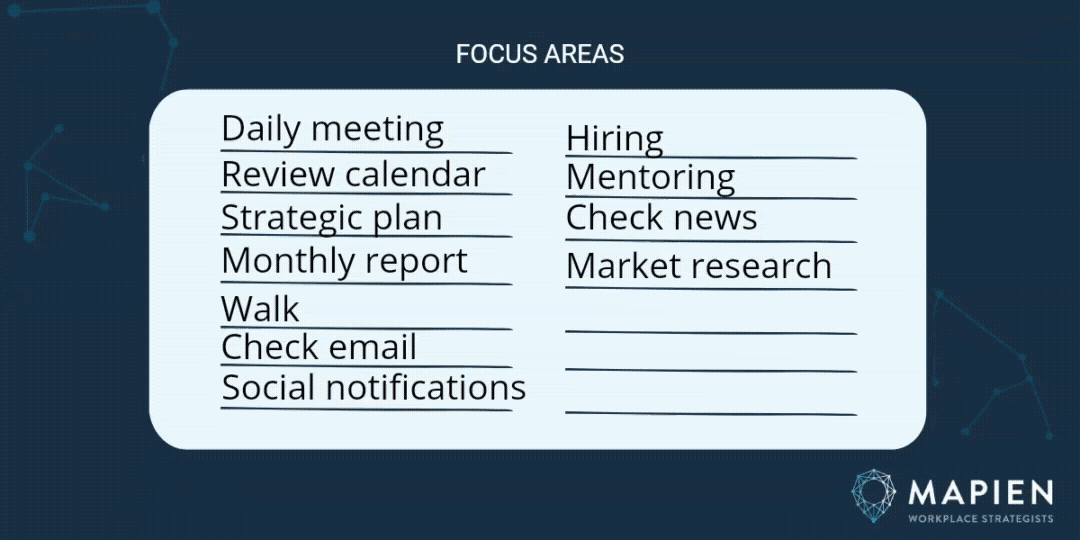
Next, you need to circle the responsibilities and commitments that you’re currently focusing most of your attention on (regardless of their urgency or importance).
(3) Objectively Evaluate Importance and Urgency
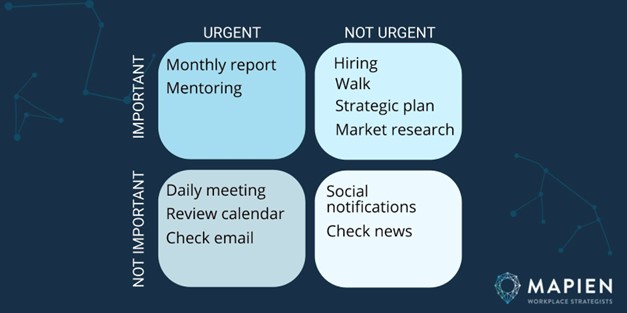
Now it’s time to reflect on your responsibilities and commitments in light of their level of importance and urgency. Consider them objectively — how do they actually impact your goal(s)? What would happen if you delayed the task or simply did not accomplish it?
Based on this reflection, place your tasks into the appropriate quadrant of your matrix.
Tip: Not everything is urgent or important, even if the adrenaline rush is telling you otherwise. That’s why it’s important to objectively evaluate your list, while keeping an eye on your key objectives or most important goals.
(4) Shift Your Attention
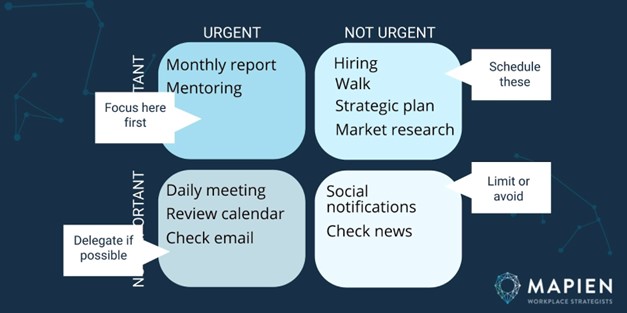
Now for the interesting bit: notice if there are any differences between the activities you’re currently focused on and those that you should be focused on. Then note down any changes you will need to make in order to better focus your attention and energy.
Benefits of the Time Management Matrix
“Not everything is worth equal time and attention.”
The main benefit of using the Time Management Matrix is an ability to prioritise, which will allow you to be more effective.
Other flow-on benefits may include:
- Setting an example – As a leader, you can be a role model to your team and show them how to better prioritise their time.
- Set new habits – Break free from your habit of prioritising based on urgency, and create positive habits that serve you for life.
- Reduce your overwhelm – Shrink your to-do list by honing your list of priorities and figuring out what to delegate, delay, or delete.
- Improved productivity – By focusing on what matters, you’ll arrive at your destination much sooner.
- Better work-life balance – By prioritising your work, you might find more time to enjoy life outside of work (and relax during your downtime).
- Greater satisfaction – Research shows that proactive decision making (made possible through this process) can enhance general self-efficacy and increase satisfaction with both decisions and life.
So, if you’ve been having a tough time deciding which of your (many) responsibilities and commitments require your attention, we’d encourage you to give the Time Management Matrix a go. In fact, you could get your priorities straight in as little as 20 minutes!
Get Support
Looking for leadership coaching or hands-on help with more great tools like this one? Contact us today!

